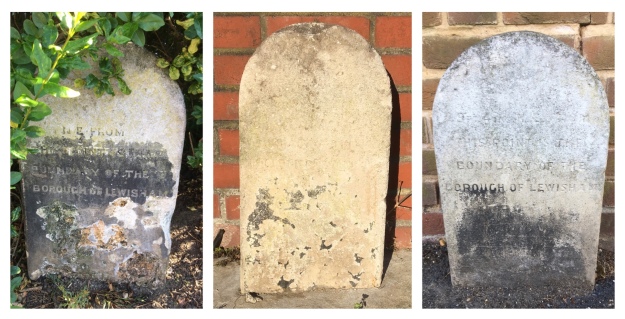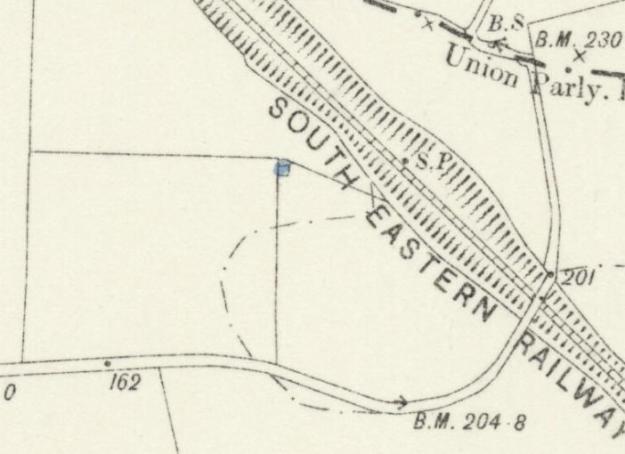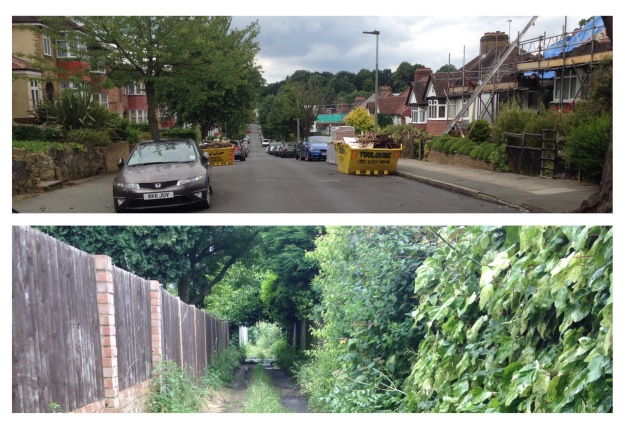During the COVID-19 lockdown Running Past has been following the boundary of Victorian Lee a few years before it was subsumed into Lewisham, aided only by a Second Edition Ordnance Survey map and a smattering of knowledge of the area. The previous two posts have taken us in stages, from Lee Green to Winn Road, appropriately passing Corona Road en route; the second took us On through Grove Park, crossing the never built Ringway, We’d left the boundary on Grove Park Road, on top of a culverted Grove Park Ditch, with a marker that had been weathered beyond any potential to decipher.

For the pedants of periphery, the boundary marker is no longer on the boundary, in adjusting it to the rear fences of Marvels Lane it has led to the now Bromley – Lewisham boundary dog legging down the middle of Grove Park Road, the small sign of the former and the larger one of the latter announce the changes.

The route followed in this section was entirely rural in 1893 as the Ordnance Survey map below shows with the Morse code dot dash line – although the most southerly end of Victorian Lee, the largely John Pound developed ‘new town’ of Grove Park is visible to the north east.

One the opposite side of Grove Park Road is the attractive Chinbrook Estate, built by the Greater London Council (GLC) in the early 1960s; it is a development that has been covered by the 21st century’s foremost chronicler of council housing, Municipal Dreams, who noted
“What was exceptional ….is the overall architectural and design quality of the Estate…..Chinbrook is a reminder of the best that might be achieved with proper investment and careful planning.”
Like the much larger Downham estate, which we will encounter further along the Lee boundary, it is an estate that straddles a boundary, Mottingham to the east, Lee to the west in 1893, at least. The 21st century boundary is slightly different and is a currently a Lewisham to Bromley one, The divisions aren’t immediately obvious, but as with Upwood Road further back, while there are no boundary stones, the 21st century markers are clear. Along with the Borough colour coded bins, the Borough street signage indicates the location – white on blue for Lewisham, white on green for Bromley (plus some faded black on white signage, perhaps from the GLC era).

Back in 1893 there was a boundary marker close to where Grove Park Ditch now enters its long culvert on the edge of the estate; if it is still there, it is lost in the dense undergrowth. Whilst the border probably ought to have followed Grove Park Ditch it doesn’t and seems to have followed field and probably ownership boundaries. So the border follows what is now a fence between the attractive Lower Marvels Wood and the rear gardens of Grace Close. The name coming from ‘W G’ who lived both in Mottingham and Sydenham. The estate provides links to other Lewisham sporting greats, Henry Cooper Way and Lions (Millwall’s nickname) Close.

Over Dunkery Road, the 2020 boundary has been slightly amended compared with its late Victorian counterpart to cope with the slight dog leg of Duddington Close. There has also been a slight adjustment to for the 1930s council housing of Bilsby Grove.
The late Victorian boundary of Lee was at the border between the woodland of Marvels Wood and farmland. The woodland remains but behind the council housing of Charminster Road the former fields have become Grove Park Cemetery. It was an out of town burial solution by the Borough of Deptford whose main burial ground, Brockley Cemetery, was almost full by the early 1930s. Running Past has covered Brockley Cemetery several times in the past, notably in relation to the murder of Jane Clouson who was buried there in the 1870s and has a large memorial.
Grove Park Cemetery was designed by their Borough Surveyor H Morley Lawson and ‘juxtaposed formal and informal elements and the cemetery buildings showed the influence of Moderne and Art Deco style.’ It was used from 1935.

From Bromley side of the boundary, the cemetery is largely hidden, albeit rather attractively by a hundred metre long mural by the seemingly now defunct Onit Design. At the top of the hill, within a metre of the boundary there is some even more impressive artwork, a chainsaw carving by Will Lee, which seems somewhat apt when following the Lee boundary. There is some more of his work about 100 metres into the woods.
A couple of metres further on there is a very weathered boundary marker which in the Victorian Ordnance Survey map was a three way marker for Lee, Mottingham and Bromley; now the bigger London Boroughs of Bromley and Lewisham. A metre or two along the path is another, hard to spot boundary marker, just inside the heavy duty palisade fencing ‘protecting’ the cemetery from the Green Chain Walk in what is now Elmstead Woods. It is unusual in the that it marks the direction of the boundary, located as it is on an angle. The direction is incorrect as it appears that the marker was moved at the time of construction of the cemetery and unintentionally rotated by 90°.
The 1893 boundary darted easterly across the fields towards Grove Park, the current variant, dating from 1991, is a little more circuitous and reflects the ownership of the cemetery and skirts its border.
There was, and probably still is, another marker at the eastern edge of the cemetery. However, in the very dense undergrowth it proved impossible to find amidst the brambles and nettles (poor companions for a short-clad runner). All was not lost though, there was a marker of sorts – a Lewisham bollard, marking the boundary of car park and Green Chain Walk.
Over the car park the Victorian boundary followed the northern edge of what are now allotments – we’ll leave the boundary there for a while before we go through Chinbrook and on to the edge of the Downham Estate.
Credits and Thanks
The Ordnance Survey map is via the National Library of Scotland on a non-commercial licence.
The series of posts on the Lee boundary that this post is part of, would probably not have happened without Mike Horne, he was the go-to person on London’s boundary markers; he had catalogued almost all of them in a series of documents. He was always helpful, enthusiastic and patient. He died of a heart attack in March but would have loved my ‘find’ of a London County Council marker in some undergrowth on Blackheath during 2020’s lockdown, and would have patiently explained the details of several others he knew to me. A sad loss, there is a lovely series of tributes to him via this link.













































